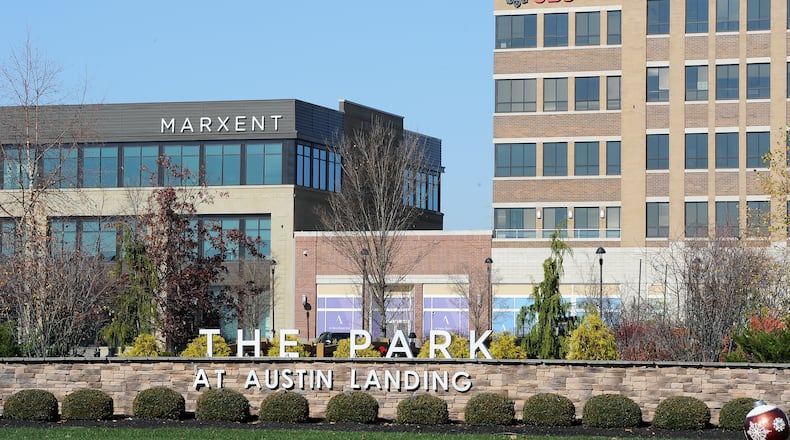No businesses have opened at the complex since then and three have closed. Bar Louie shut its doors in January. Bar 145 never reopened after the pandemic closed most businesses in March, with its owners confirming in September that the closure was permanent. The Spicy Olive owner Melanie Cedargren this summer relocated to the Shops of Oakwood.
The COVID-19 outbreak has hurt most large retail centers in the Dayton area and accelerated growing consumer preferences for e-commerce, according to a recent report from Colliers International-Dayton.
During the third quarter of 2020, Dayton’s retail market vacancy rate increased to 10.8% of square foot retail space, according to the report.
“Most of the loss was at larger community centers like Austin Landing, while neighborhood and strip centers suffered little change,” said Kendall Goodrich, professor and chair of the marketing department at Wright State University’s Soin College of Business. “Even prior to COVID-19, retailers were dealing with growing competition from e-commerce and changing consumer preferences toward online shopping, trends that were accentuated by the pandemic.”
Austin Landing is geographically the best-positioned Dayton-area retail development to benefit from growth of the Cincinnati-Dayton growth corridor, Goodrich said.
Jennifer Blair, the site’s property manager, said Austin Landing is a healthy complex that has been operating well in recent months, but has been unable to make many improvements, “because we don’t know what the health of retail looks like.”
Although COVID-19 has made it difficult for Columbia Investment officials to visit the site this year, they have their eyes on growth in 2021, said Blair, who has helped manage the property since 2015.
Only about 2,500 square feet of office space remains unleased, “so we’re pretty full," she said. Less than 30,000 square feet of retail space is available.
“We’ve had a lot of activity here,” Blair said. “Our brokers are heavily marketing all of the spaces that we have available to regional and national tenants.”
Chris Snyder, Miami Twp.'s director of community development, said that township officials, prior to the opening of Austin Boulevard Interchange in July 2010, had encouraged mixed use projects to come to the area.
Conceived by Randy Gunlock of RG Properties from its inception as a mixed-use project, the first Austin Landing building, which once housed the now-departed Teradata, debuted in fall 2010. Kohls joined as an early anchor in 2011 and Hilton Garden Inn and Kroger opened in 2013.
But it wasn’t until the creation of a centerpiece park and the buildings surrounding it that the project started to turn into a destination spot, Snyder said. Under the guidance of RG Properties — and later VisCap Development President Larry Dillin — a mix of office, retail, restaurants and bars started flocking to the site in 2014. That included multimillion dollar projects such as Field & Stream, Cinepolis, Progress Park Tower, Staybridge Suites and The Flats at Austin Landing, a $35 million, 276-unit luxury apartment complex.
“The focus was on making sure that development supported good employment, higher-paying, good quality jobs, that the service-oriented development components and amenities that were going to go along with that were going to be of a high quality and support not just the community, but the office development, the employment that was brought into the area,” Snyder said.
Austin Landing includes 142 acres of property, of which 40 acres to the north of the Hilton and Innovation Drive are owned by Mount Adams Property LLC, he said. All acreage is part of the original planned development and any future development of the parcel would still be covered by the regulations of the Austin Landing Planned Development.
Despite this year’s closings, Austin Landing’s overall economic viability remains “very positive, very strong," Snyder said. Its visibility along I-75 will remain an asset after the pandemic ends, he said.
“Obviously, the pandemic’s a real challenge for retail development and certainly cinemas, restaurants and bars," he said. “In particular, the bars have had a challenge during the pandemic. But we’re looking forward that ultimately we’re going to get through this and come out on the other side of this.”
In communities nationwide, office users are trying to decide if they want to retain the same type of space they have had, and Austin Landing will not be exempt from that, he said.
“There’s certainly going to be a transition,” Snyder said. “There’s going to be a period where there’s going to be some downsizing in certain areas.”
Some downsizing is set to happen at Austin Landing, which by year’s end will go from about 2,500 square feet of available office space to about 25,000 due to tenant relocation, Blair said.
But at least seven tenants have chosen to renew their leases, she said.
Ultimately, the positive aspects that are working in favor of Austin Landing will ultimately to attract users, Snyder said.
“If you have an office development that downsizes, that’ll open up space for other folks that want to be in that area and couldn’t be otherwise because there wasn’t space,” he said. “Prior to the pandemic, outside of the Teradata box, almost all of the office space was fully leased.”
About the Author

